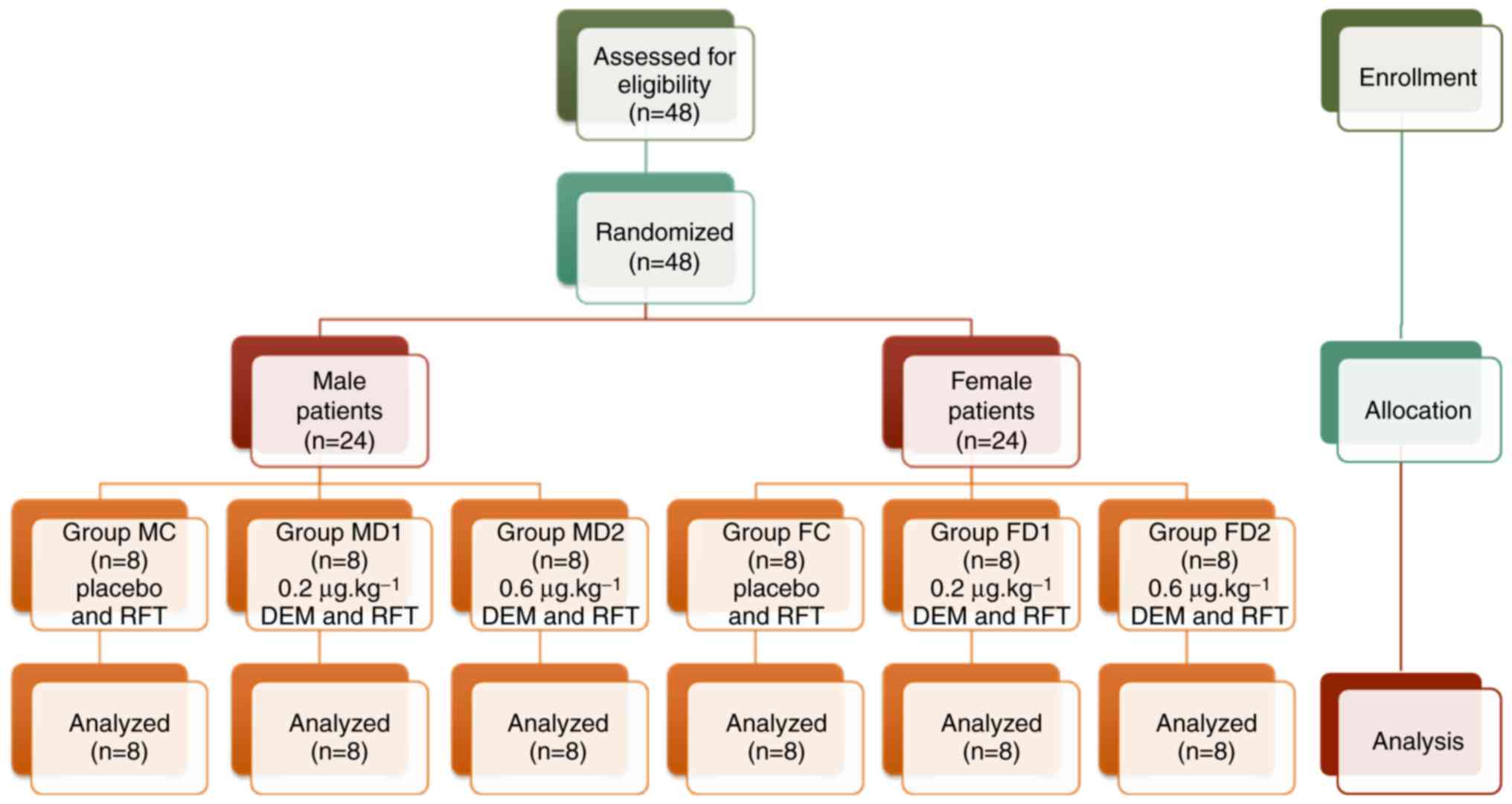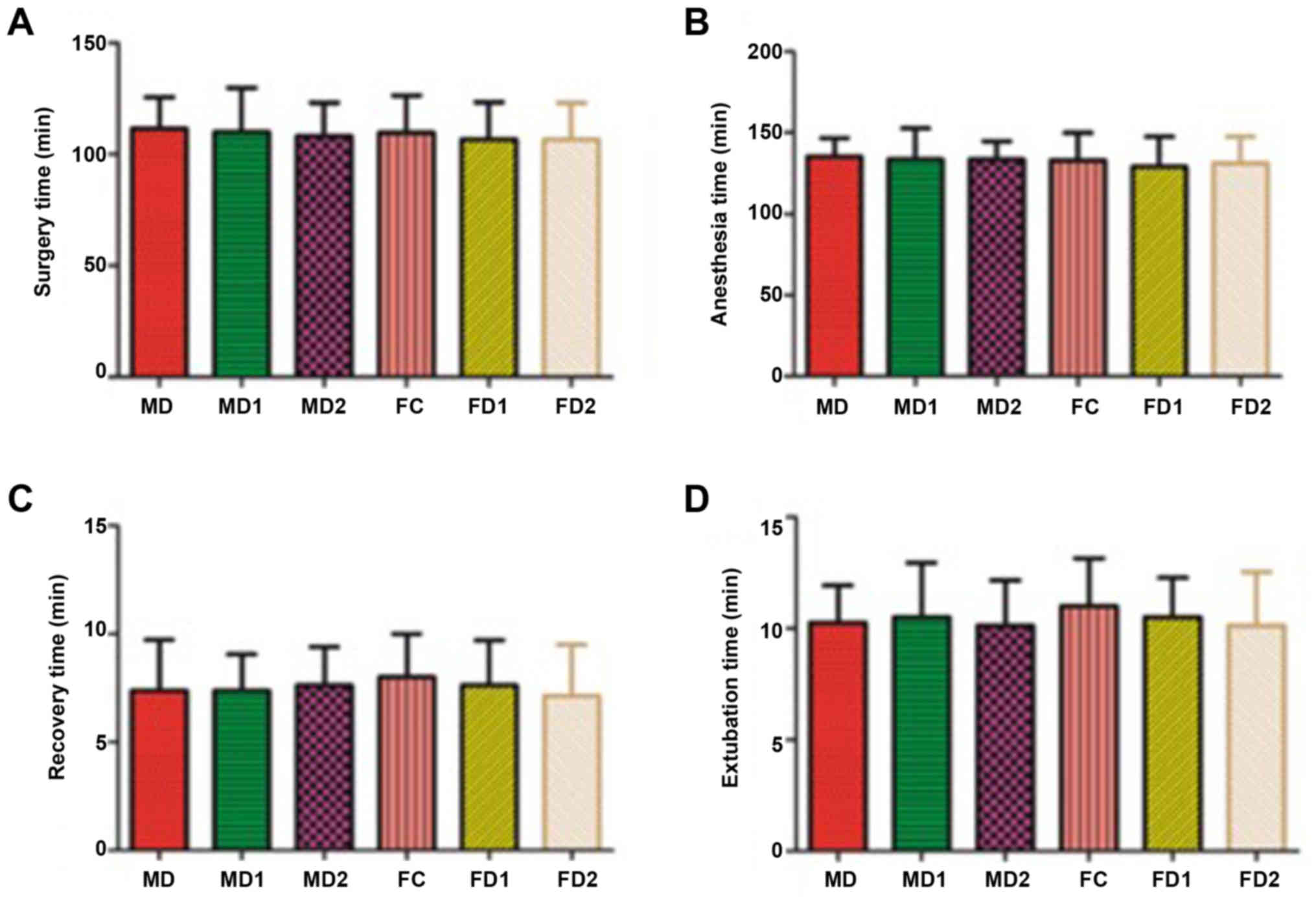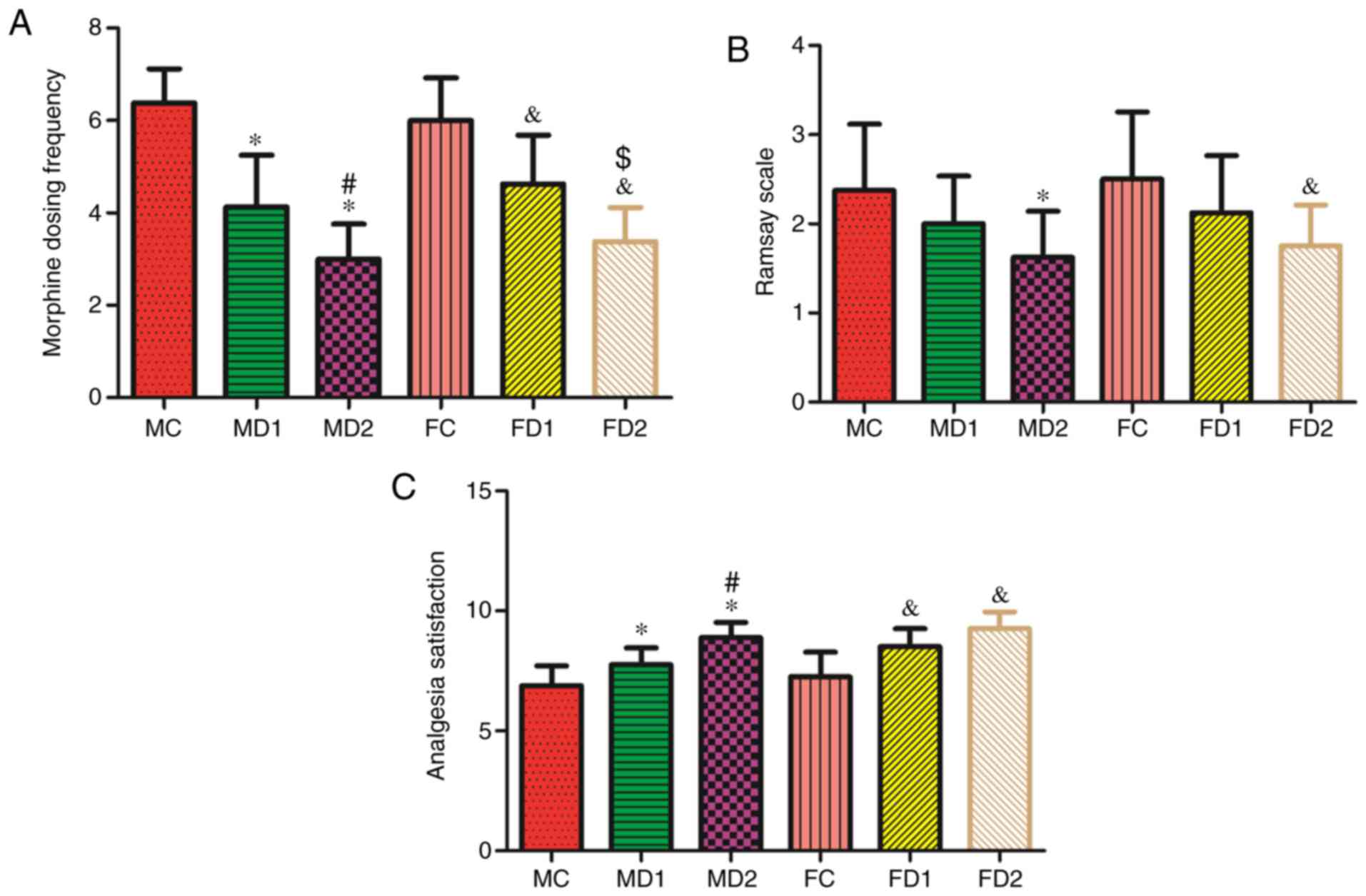Introduction
Remifentanil is a potent, short-acting synthetic
opioid analgesic drug which has been widely used in clinical
practice for pain management during perioperative period. Its
unique pharmacokinetic features such as achieving the therapeutic
effect in a short time and extremely rapid clearance rate makes it
a favourable analgesic drug for medical procedures (1). However, both clinical and experimental
studies indicated that remifentanil had the potential to increase
pain sensitivity, distribution or intensity associated with
irritation of pain receptors or sensory nerves (2,3).
Remifentanil-induced hyperalgesia (RIH) has become more important
as the patients received prolonged or escalating dosages of
remifentanil, which in turn results in increased postoperative pain
and higher opioid consumption (4).
One study investigated postoperative analgesia and recovery in
patients after abdominal hysterectomy indicated that postoperative
pain is one of the key causes of prolonged recovery following
abdominal surgery. Also, anesthesia management has the potential to
reduce surgery-induced pain (5).
Therefore, it is necessary to investigate relevant
strategies to avoid or attenuate the influence of RIH after
infusion of remifentanil post-operatively. Many experimental
studies have been published in this field. Some studies suggested
that N-methyl-D-aspartate (NMDA) receptor antagonists such as
ketamine may play a role as a useful adjuvant to reduce RIH
(6–8). COX-2 inhibitor parecoxib which were
also investigated as nonsteroidal anti-inflammatory drugs were
often administered as premedication before surgery (9,10).
Whereas other researches focused on modulating the administration
of remifentanil as a different approach to avoid the side effects
of adjuvants. Comelon demonstrated that gradual withdrawal of
remifentanil infusion may prevent RIH compared with abrupt
withdrawal (11). While in clinical
cases where patients do not respond to them or cannot be treated
with regional analgesic techniques, systemic α2 agonists could be
utilized (4,12).
Dexmedetomidine is a highly selective α2 adrenergic
agonist with sedative effects and analgesic-sparing properties, it
also has the advantage of causing less respiratory depression
comparing with other commonly used sedatives (13,14). A
systematic review has been demonstrated that α2 adrenergic receptor
agonists such as dexmedetomidine may provide benefit in the
treatment of RIH by decrease postoperative pain intensity and
morphine consumption (15).
Furthermore, animal studies on α2 adrenergic receptor agonists have
been shown to produce significant synergy with opioids in mice
(16). However, the precise
molecular mechanism of opioid-induced hyperalgesia (OIH) is
currently unknown, there are no specific preventive measures for
the high incidence of RIH (17).
Consequently, this study aimed to provide a
theoretical basis for the clinical application of dexmedetomidine
on prevention of RIH after operation; we also evaluate the gender
differences on RIH by comparing the effect of using remifentanil
alone or combined with high-dose or low-dose dexmedetomidine in
patients undergoing thyroidectomy.
Materials and methods
Methods
This randomized double blind controlled trial was
approved by Institutional Medical Ethics Committee of Tianjin
Medical University General Hospital and formal, written consent
from all participants was obtained.
The method of using visual analog scale (VAS) were
informed to the participants before the surgery, which is
unidimensional measurement instrument of pain intensity. VAS
consist of a horizontal straight line which is 100 mm long, with
the left end of the line representing no pain and the right end of
the line representing pain as bad as it could possibly be. After
the operation, participants were instructed to indicate the
position on the scale that best describes their perception of pain
at that time. Von Frey filaments (Bioseb™, Chaville,
France) was used to measure the mechanical hyperalgesia threshold
after the operation. This type of anesthesiometer consist of 20
monofilaments with size ranges from 1.65–6.65 and force ranges from
0.008–300 g. When the tip of a fiber is pressed against the skin
surface at right angles, the participants were instructed to
respond ‘yes’ or ‘no’ if that contact was felt or not felt. The
researcher continues to advance the probe and the force of
application increases until the elastic column buckled. After the
fiber buckles, continued compress creates more bend, but the force
contributed by the column is fairly constant. We continued apply a
larger filament until the patient gave a positive response. The
lowest force (g.mm−2) necessary to bend a Von Frey
filament was defined as the mechanical hyperalgesia threshold.
Subjects
We selected forty-eight American Society of
Anesthesiologists physical status I–II patients (24 male, 24
female) aged between 18–65 years who were scheduled for
thyroidectomy from the general surgery department in the hospital.
The operation time is limited between 1–4 h with the necessity of
extubation afterwards. All the selected patients were able to
communicate verbally during their participation in this clinical
research. Exclusion criteria regarding to patient's medical history
were allergy to dexmedetomidine or other drugs; long-term use of
narcotic analgesics, sedative or non-steroid anti-inflammatory drug
(NSAIDS); neuromuscular disease, endocrine system disease or
psychiatric conditions. Perioperative exclusion criteria were
preoperative heart rate HR <50 bpm, SBP <100 mmHg, abnormal
cardiac conduction or rhythm; blood loss >600 ml or re-operative
patients; patients participated in clinical trials of other drugs
in the past 3 month and patients identified by the researchers as
inappropriate to participate in the clinical trials.
Groups
Twenty four male patients were randomly divided in
to three groups (n=8 per group) using computer generated random
number tables. The male controlled group (MC) received a
preoperative placebo of 0.2 µg.kg−1 normal saline and
intraoperative remifentanil 0.2 µg.kg−1.min−1
intravenously by infusion pump. The second male (MD1) group
received low dose preoperative dexmedetomidine 0.2
µg.kg−1 and intraoperative remifentanil 0.2
µg.kg−1.min−1. The third (MD2) group received
higher dose of preoperative dexmedetomidine 0.6 µg.kg−1
and intraoperative remifentanil 0.2
µg.kg−1.min−1. For twenty-four female
patients, they were also randomly divided into three groups: FC,
FD1 and FD2. The female controlled group (FC) received normal
saline. within each group, same methods and dosages of
dexmedetomidine and remifentanil for these group were applied.
Anesthesia
Patients were given general anesthesia with tracheal
intubation. Induction of anesthesia was commenced with intravenous
midazolam 0.06 mg.kg−1, propofol 1–3 mg.kg−1,
remifentanil 1 µg.kg−1, rapid tracheal intubation was
facilitated by rocuronium to assist ventilation. During operation,
propofol 3–5 mg.kg−1.h−1, remifentanil 0.2
µg.kg−1.min−1 and rocuronium bromide were
used to maintain the bispectral index (BIS) values between 40–60.
Conventional care was given for the prevention of nausea and
vomiting by navoban 4 mg. Upon completion of induction, if SBP
<80 mmHg, or a decrease of more than 30% of the basic blood
pressure, phenylephrine 0.05–0.1 mg was injected intravenously with
increased infusion speed. Repeat this procedure when necessary; if
SBP >180 mmHg, intravenous nitroglycerin 0.25–0.5 mg or urapidil
5–10 mg was given with slow infusion, repeat the procedure if
necessary; when patient's HR <50 bpm, intravenous atropine
0.2–0.5 mg was injected, repeat when necessary; when patient's HR
>110 bpm, esmolol 0.5 mg.kg−1 was given
intravenously, repeat when necessary.
Data collection
Postoperative care was given in the Post Anesthesia
Care Unit (PACU) for 2 h. During the observation period patient's
VAS was maintained ≥3 with morphine 0.1 mg.kg−1
intravenous injection. The incidence of postoperative adverse
reaction within 24 h such as nausea, vomiting, chills and
respiratory depression were recorded. Other observation index
includes: preoperative 30 min, 1, 2, 4, 8, 24 h VAS; Ramsay score
10 min after extubation; time to first postoperative analgesic
requirement and analgesic consumption in the PACU stay and
patient's mechanical pain threshold at 30 min, 1, 2, 4, 8, 24 h
postoperatively. In addition, patient satisfaction score on
analgesic effect was also documented.
Statistical analysis
Categorical variables were described as number while
numeric variables were expressed as mean ± standard deviation.
Comparison of six groups and following parameters were accomplished
by one-way ANOVA followed by Tukey's test using Statistical Package
for Social Sciences Statistics (SPSS) software, v19.0 (SPSS, Inc.,
Chicago, IL, USA): Age, body weight, duration of operation,
anesthesia time, recovery time, time to extubation after surgery,
mechanical hyperalgesia threshold, 10mins after extubation Ramsay
score, patient's analgesia satisfaction score, time to first
postoperative analgesic requirement and analgesic consumption.
Chi-square tests were used to analyze analgesic-related adverse
effects such as PONV, chills and respiratory depression. P<0.05
was considered to indicate a statistically significant
difference.
Results
Demographic data and
anesthesia-related information
A total of 48 patients undergoing thyroidectomy
under remifentanil-based anesthesia were assessed for eligibility
and divided into three male groups and three female groups after
randomization. No patient was dropped during the study (Fig. 1).
There was no significant difference among the six
groups with respect to anesthetic parameters such as age, body
weight, duration of anesthesia or time to extubation after surgery.
Recovery time and extubation time were slightly higher in the
female controlled group (FC) than other groups (Fig. 2).
Postoperative VAS evaluation
Postoperative mechanical pain threshold measured by
VAS was significantly lower in group MD1 at 30 min, 2, 4, 8 and 24
h postoperative time points, respectively (P<0.05). For group
MD2, significantly different VAS scores was shown at all of the
time points compared with group MC (P<0.05). For female groups,
the mechanical pain threshold in group FD1 at all the
post-operative time points were all significantly lower compared
with those of group FC except at 1 h. At the same time, group FD2
has shown significant difference at all the post-operative time
points compared with group FC (P<0.05). In addition, the
mechanical pain threshold at the operation site was not
significantly different among the different gender difference
groups (Fig. 3).
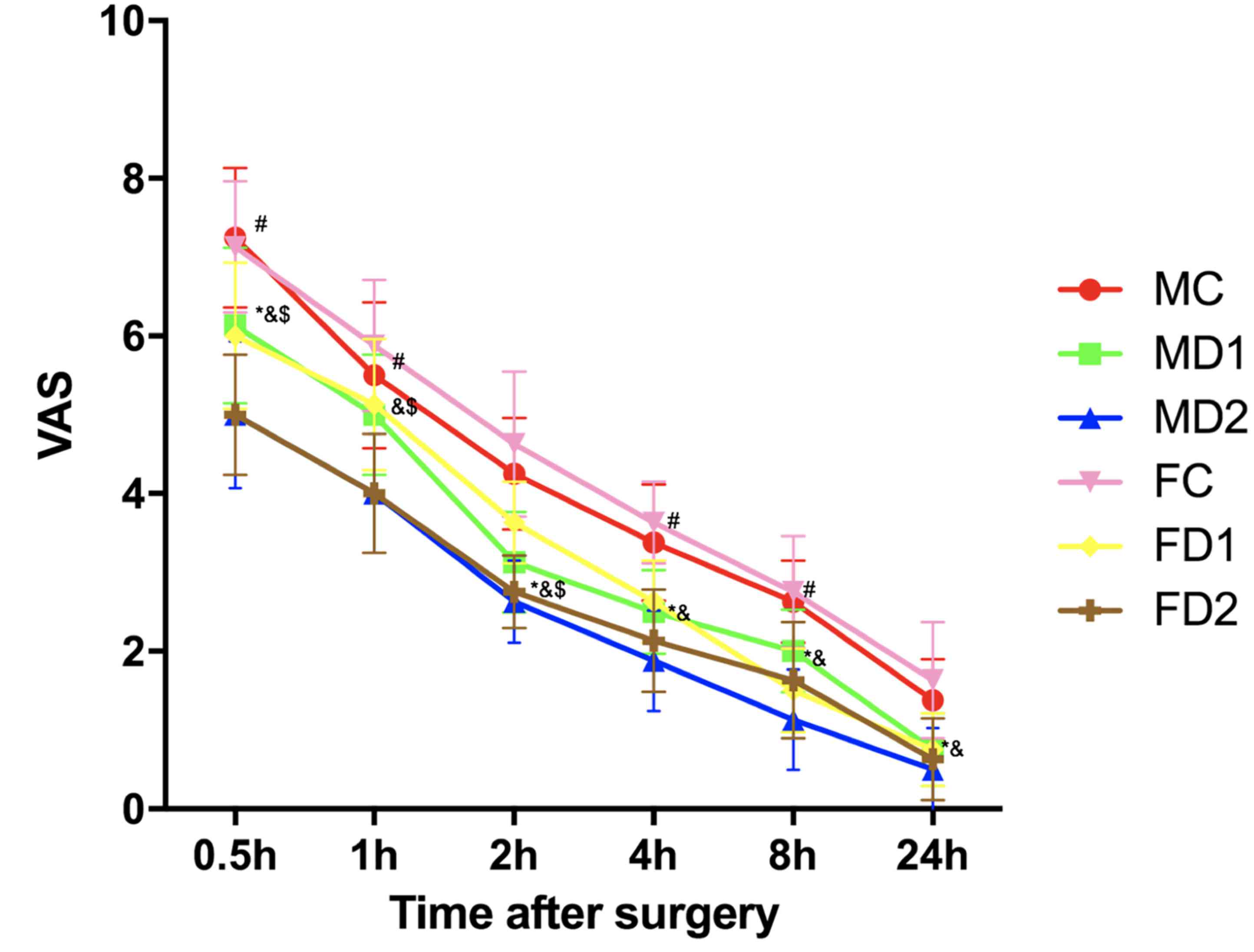 | Figure 3.Postoperative mechanical pain
threshold measured with VAS. Group MC/FC, male/female controlled
group received placebo + remifentanil (0.2
µg.kg−1.min−1); Group MD1/FD1, male/female
group, received low-dose dexmedetomidine (0.2 µg.kg−1) +
remifentanil (0.2 µg.kg−1.min−1); Group
MD2/FD2, male/female group received high-dose dexmedetomidine (0.6
µg.kg−1) + remifentanil (0.2
µg.kg−1.min−1). VAS was measured at 30-min,
1, 2, 4, 8 and 24-h time points after surgery. Values were
expressed as median and the error bars indicate the interquartile
range. *P<0.05 vs. Group MC, #P<0.05 vs. Group
MD1, &P<0.05 vs. Group FC and
$P<0.05 vs. Group FD1. VAS, visual analog scale. MC,
male controlled group; FC, female controlled group. |
The post-operative mechanical hyperalgesia threshold
at all the time points was significantly lower in group MC compared
with other male groups. For female groups, same results were
obtained (P<0.05; Fig. 4).
Post-operative morphine dosing frequency was significantly higher
in both group MC and FC (P<0.05). Furthermore, high-dose
dexmedetomidine groups MD2 and FD2 showed significantly lower
morphine dosing frequency compared with low-dose groups (MD1 and
FD1) (Fig. 5).
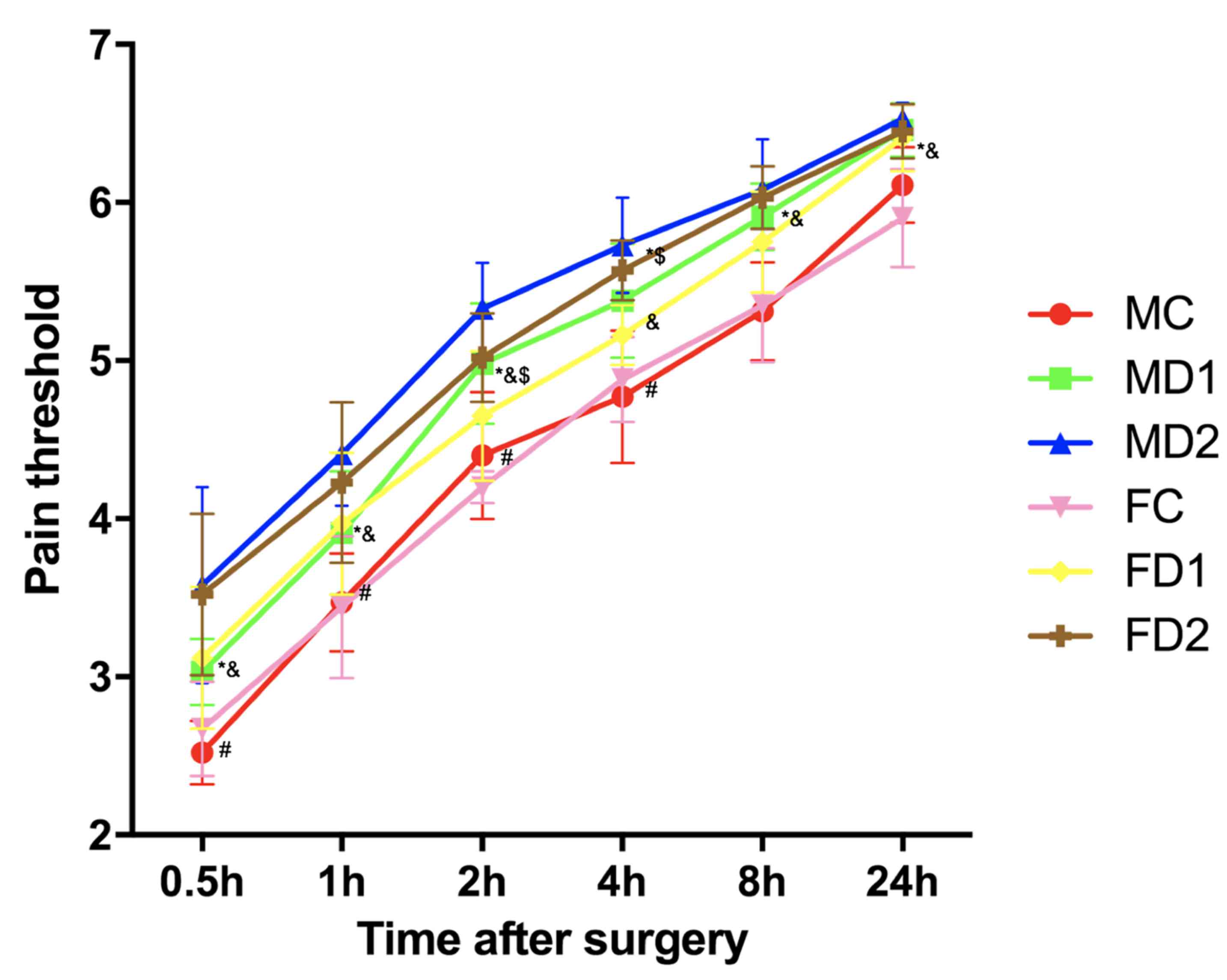 | Figure 4.Post-operative mechanical
hyperalgesia threshold. Group MC/FC, male/female controlled group
received placebo + remifentanil (0.2
µg.kg−1.min−1); Group MD1/FD1, male/female
group, received low-dose dexmedetomidine (0.2 µg.kg−1) +
remifentanil (0.2 µg.kg−1.min−1); Group
MD2/FD2, male/female group received high-dose dexmedetomidine (0.6
µg.kg−1) + remifentanil (0.2
µg.kg−1.min−1). Pain threshold were measured
at 30-min, 1, 2, 4, 8 and 24-h time points after surgery. Values
were expressed as medians and the error bars indicate the
interquartile range. *P<0.05 vs. Group MC, #P<0.05
vs. Group MD1, &P<0.05 vs. Group FC and
$P<0.05 vs. Group FD1. MC, male controlled group; FC,
female controlled group. |
Postoperative Ramsay scale
Post-operative sedation level of the patients were
assessed by Ramsay scale, both MD2 group and FD2 had a significant
lower score compared with the other groups (P<0.05). Patient's
analgesia satisfaction score were significantly higher in both
gender groups with dexmedetomidine as an adjuvant to analgesia
intra-operatively (P<0.05; Fig.
5).
Postoperative adverse effects
The incidence of Post-Operative Nausea and Vomiting
(PONV) was significantly higher in group MC and FC. Post-anesthetic
chills was significantly lower in group MD2 and FD2. None of the
patient developed respiratory depression during recovery period
(Table I).
 | Table I.Postoperative side effects. |
Table I.
Postoperative side effects.
|
| Group MC (n=8) | Group MD1
(n=8) | Group MD2
(n=8) | Group FC (n=8) | Group FD1
(n=8) | Group FD2
(n=8) |
|---|
| Nausea and
vomiting | 5 | 3 | 0 | 4 | 2 | 1 |
| Chills | 3 | 1 | 0 | 2 | 1 | 0 |
| Respiratory
depression | 0 | 0 | 0 | 0 | 0 | 0 |
Discussion
In the present study, RIH was significantly
attenuated by intraoperative infusion of low-dose (0.2
µg.kg−1) or high-dose (0.6 µg kg−1)
dexmedetomidine in patients undergoing thyroidectomy. However, the
protective effects against remifentanil-induced hyperalgesia of
dexmedetomidine showed minimal significant differences between two
gender groups.
In the present study, RIH was revealed as enhanced
pain intensity, reduced mechanical hyperalgesia threshold and
increased morphine consumption obtained from high dose
intraoperative remifentanil. Compared with patients in controlled
groups, the patients in groups with dexmedetomidine infusion had
lower VAS scores, greater mechanical pain threshold and less
postoperative morphine consumption.
Postoperative nausea and vomiting (PONV) was a
common complication of general anesthesia and spinal anesthesia.
Recently, the effect of dexmedetomidine on PONV has been the focus
of clinical researches. As an α2 adrenergic receptor agonist, it
decreases sympathetic activity by reducing level of catecholamine
and/or its opioid-sparing effect (18). Two meta-analysis suggested that
administration of dexmedetomidine decrease the incidence of PONV
(15,19). This finding was consistent with our
study as both MC and FC group has had the higher number of PONV
patients, and the number of patients decreased as the dosage of
dexmedetomidine increased.
Dexmedetomidine was proved to be effective in
suppressing the post anesthetic shivering in patients who underwent
general anesthesia. It reduces shivering by lowering shivering
thresholds and vasoconstriction (20). The result of the present study
support the fact that dexmedetomidine have antihyperalgesic and
antishivering effects. In addition, none of the patient reported
respiration depression during recovery. These results were
consistent with other studies regarding to hemodynamic effects of
α2 adrenergic receptor agonists (15,21).
Currently, opioid-induced hyperalgesia remains as a
clinical challenge in different pain settings due to lack of clear
diagnostic criteria, limited alternative options of opioid
analgesics and risk of opioid withdrawal with opioid reduction
(22). The exact molecular mechanism
of OIH is not yet understood. One of the proposed mechanisms of
acute opioid hyperalgesia was glutamate-associated activation of
N-methyl-D-aspartate (NMDA) receptors caused spinal neuron
sensitization. NMDA receptors are composed of different types of
subunits, the NMDA receptor 2B (NR2B) subunit plays the most
important role in spinal dorsal horn sensory pathways (23). Moreover, the capability of NMDA
receptor antagonists to suppress OIH provides further evidence that
NMDA receptors are involved in hyperalgesia states (23–25).
While other studies have suggested that a splice variant of the mu
opioid receptor known as MOR-1K contributes to the development of
OIH. Human genetic and cell signaling studies supported the
evidence that MOR-1K produces increased cellular activity via
Gs signaling while decrease opioid analgesic responses
(26,27). Other mechanisms suggested were
increased excitatory peptide neurotransmitters such as
cholecystokinin (CCK), caused by the release of endogenous opioid
spinal dynorphin which activates the kappa opioid receptor and NMDA
receptors (28), genetic influence
of the Catechol-O-methyltransferase (COMT) gene which was an enzyme
that breakdown catecholamines and regulates the metabolism of
dopamine/noradrenaline (29), and
decreased reuptake of neurotransmitters such as substance P and
gultamate from the primary afferent fibers along will increase the
responsiveness of the spinal neurons to the transmitters after
chronic opioid intake (30). In this
study, we found that intraoperative high-dose remifentanil was
associated with increased pain intensity. Therefore, leading to
greater morphine consumption, decreased mechanical hyperalgesia
threshold and higher Ramsay score. In addition, both controlled
male and female group (MD & FD) had a significant lower
analgesia experience satisfaction score compared with the other two
experimental groups. This was studied from patient's
perspective.
Dexmedetomidine was first introduced into clinical
use as a short-term sedative because it is a rapidly-metabolized
drug with a short plasmatic half-time of 2–2.5 h (11). It is chemically related to clonidine,
but has a much greater affinity for α2 receptors over α1 receptors.
In the dorsal horn of the spinal cord, the presence of
dexmedetomidine at α2 adrenergic receptors modulates the release of
substance P and produceds its analgesic effects (31). Its molecular mechanism has been
investigated by animal models, Yuan et al (32) reported that dexmedetomidine could
prevent RIH via regulating spinal NMDA receptor trafficking as well
as protein kinase C and calmodulin-dependent protein kinase II
pathway. This result was consistent with other animal studies that
suggested combination of α2 adrenergic receptor agonist with an
opioid can increase analgesic potency to some extent (33,34).
Moreover, by effectively suppressing glial cell proliferation and
activate the adjacent nerve cells involved in peripheral and
central sensitization, dexmedetomidine has been shown effectively
decreasing hyperalgesia by increasing acetylcholine levels in the
spinal cord (35). Several clinical
trials and case reports have confirmed that dexmedetomidine as an
α2 adrenergic agonist has the potential to synergize with opioids
(4,15,35).
Therefore, dexmedetomidine was set out as an adjuvant to reduce RIH
and improving pain control in patient undergoing thyroidectomy. In
our study, both low dose and high dose dexmedetomidine groups has
significant reduction in morphine dosing frequency after operation,
in particular, high-dose dexmedetomidine was more effective than
low-dose dexmedetomidine in male and female group. Furthermore, VAS
scores were significantly lower in groups with either high or low
dose of dexmedetomidine compared with the groups receiving placebo.
Our data correspond with other supporting evidence indicated that
dexmedetomidine infusion efficiently alleviated RIH symptoms
(35,36).
In conclusion, we found that both low dose and high
dose dexmedetomidine intraoperative infusion significantly
decreased the patient's risk of enhanced pain intensity and
increased postoperative morphine consumption caused by remifentanil
induced hyperalgesia. Patient reported higher analgesia
satisfaction when dexmedetomidine was utilized as an adjuvant in
pain management. The protective effects against
remifentanil-induced hyperalgesia of dexmedetomidine showed minimal
significant differences between two gender groups. Additional
studies are required to determine the rational regimens and to
clarify the adverse effect of dexmedetomidine. Although the
research has reached its aims, there were some unavoidable
limitations. Due to time limit and limited resources, this research
was conducted only on a small size of population. Therefore, to
generalize the results for larger groups, the study should have
involved more participants at different levels. Second,
multivariate analysis was not performed in this study. A univariate
model is less comprehensive compared to multivariate models and are
unable to show relationships between different factors.
Multivariate analysis should be considered in the further
studies.
Acknowledgements
Not applicable.
Funding
The present study was funded by Tianjin Medical
University International Medical School.
Availability of data and material
All data and materials generated and analyzed during
the current study are available from the corresponding author on
reasonable request.
Authors' contributions
HQ wrote the manuscript and revised it critically
for important intellectual content. ZS made substantial
contributions to conception and design. FS, RA, PC, GP and ZM made
substantial contributions to the acquisition of data, analysis and
interpretation of data. YY provided final approval of the version
to be published and agreed to be accountable for all aspects of the
work in ensuring that questions related to the accuracy or
integrity of any part of the work were appropriately investigated
and resolved.
Ethics approval and consent to
participate
This randomized double blind controlled trial was
approved by Institutional Medical Ethics Committee of Tianjin
Medical University General Hospital and obtained formal written
consent from all participants.
Patient consent for publication
Not applicable.
Competing interests
The authors declare that they have no competing
interests.
References
|
1
|
Egan TD: Remifentanil pharmacokinetics and
pharmacodynamics. A preliminary appraisal. Clin Pharmacokinet.
29:80–94. 1995. View Article : Google Scholar : PubMed/NCBI
|
|
2
|
Yu EH, Tran DH, Lam SW and Irwin MG:
Remifentanil tolerance and hyperalgesia: Short-term gain, long-term
pain? Anaesthesia. 71:1347–1362. 2016. View Article : Google Scholar : PubMed/NCBI
|
|
3
|
Kim SH, Stoicea N, Soghomonyan S and
Bergese SD: Remifentanil-acute opioid tolerance and opioid-induced
hyperalgesia: A systematic review. Am J Ther. 22:e62–e74. 2015.
View Article : Google Scholar : PubMed/NCBI
|
|
4
|
Belgrade M and Hall S: Dexmedetomidine
infusion for the management of opioid-induced hyperalgesia. Pain
Med. 11:1819–1826. 2010. View Article : Google Scholar : PubMed/NCBI
|
|
5
|
Ge DJ, Qi B, Tang G and Li JY:
Intraoperative dexmedetomidine promotes postoperative analgesia and
recovery in patients after abdominal hysterectomy: A double-blind,
randomized clinical trial. Sci Rep. 6:215142016. View Article : Google Scholar : PubMed/NCBI
|
|
6
|
Joly V, Richebe P, Guignard B, Fletcher D,
Maurette P, Sessler DI and Chauvin M: Remifentanil-induced
postoperative hyperalgesia and its prevention with small-dose
ketamine. Anesthesiology. 103:147–155. 2005. View Article : Google Scholar : PubMed/NCBI
|
|
7
|
Yalcin N, Uzun ST, Reisli R, Borazan H and
Otelcioglu S: A comparison of ketamine and paracetamol for
preventing remifentanil induced hyperalgesia in patients undergoing
total abdominal hysterectomy. Int J Med Sci. 9:327–333. 2012.
View Article : Google Scholar : PubMed/NCBI
|
|
8
|
Choi E, Lee H, Park HS, Lee GY, Kim YJ and
Baik HJ: Effect of intraoperative infusion of ketamine on
remifentanil-induced hyperalgesia. Korean J Anesthesiol.
68:476–480. 2015. View Article : Google Scholar : PubMed/NCBI
|
|
9
|
Lenz H, Raeder J, Draegni T, Heyerdahl F,
Schmelz M and Stubhaug A: Effects of COX inhibition on experimental
pain and hyperalgesia during and after remifentanil infusion in
humans. Pain. 152:1289–1297. 2011. View Article : Google Scholar : PubMed/NCBI
|
|
10
|
Tröster A, Sittl R, Singler B, Schmelz M,
Schüttler J and Koppert W: Modulation of remifentanil-induced
analgesia and postinfusion hyperalgesia by parecoxib in humans.
Anesthesiology. 105:1016–1023. 2006. View Article : Google Scholar : PubMed/NCBI
|
|
11
|
Comelon M, Raeder J, Stubhaug A, Nielsen
CS, Draegni T and Lenz H: Gradual withdrawal of remifentanil
infusion may prevent opioid-induced hyperalgesia. Br J Anaesth.
116:524–530. 2016. View Article : Google Scholar : PubMed/NCBI
|
|
12
|
Sheehy KA, Finkel JC, Darbari DS, Guerrera
MF and Quezado ZM: Dexmedetomidine as an adjuvant to analgesic
strategy during vaso-occlusive episodes in adolescents with
sickle-cell disease. Pain Pract. 15:E90–E97. 2015. View Article : Google Scholar : PubMed/NCBI
|
|
13
|
Kamibayashi T and Maze M: Clinical uses of
alpha2-adrenergic agonists. Anesthesiology. 93:1345–1349. 2000.
View Article : Google Scholar : PubMed/NCBI
|
|
14
|
Zhang X and Bai Z: New therapeutic uses
for an alpha2 adrenergic receptor agonist-dexmedetomidine in pain
management. Neurosci Lett. 561:7–12. 2014. View Article : Google Scholar : PubMed/NCBI
|
|
15
|
Blaudszun G, Lysakowski C, Elia N and
Tramèr MR: Effect of perioperative systemic α2 agonists on
postoperative morphine consumption and pain intensity: Systematic
review and meta-analysis of randomized controlled trials.
Anesthesiology. 116:1312–1322. 2012. View Article : Google Scholar : PubMed/NCBI
|
|
16
|
Gold MS, Dastmalchi S and Levine JD: Alpha
2 adrenergic receptor subtypes in rat dorsal root and superior
cervical ganglion neurons. Pain. 69:179–190. 1997. View Article : Google Scholar : PubMed/NCBI
|
|
17
|
Lee M, Silverman SM, Hansen H, Patel VB
and Manchikanti L: A comprehensive review of opioid-induced
hyperalgesia. Pain Physician. 14:145–161. 2011.PubMed/NCBI
|
|
18
|
Zhong WG, Ge XY, Zhu H, Liang X, Gong HX,
Zhong M and Xiao X: Dexmedetomidine for antiemesis in gynecologic
surgery: A meta-analysis of randomized controlled trials. Int J
Clin Exp Med. 8:14566–14576. 2015.PubMed/NCBI
|
|
19
|
Jin S, Liang DD, Chen C, Zhang M and Wang
J: Dexmedetomidine prevent postoperative nausea and vomiting on
patients during general anesthesia: A PRISMA-compliant meta
analysis of randomized controlled trials. Medicine (Baltimore).
96:e57702017. View Article : Google Scholar : PubMed/NCBI
|
|
20
|
Bajwa SJ, Gupta S, Kaur J, Singh A and
Parmar S: Reduction in the incidence of shivering with
perioperative dexmedetomidine: A randomized prospective study. J
Anaesthesiol Clin Pharmacol. 28:86–91. 2012. View Article : Google Scholar : PubMed/NCBI
|
|
21
|
Kumar A, Shinha C, Kumar A and Kumari P:
The effect of intravenous dexmedetomidine compared to propofol on
patients hemodynamics as a sedative in brachial plexus block: A
comparative study. Anesth Essays Res. 11:201–205. 2017. View Article : Google Scholar : PubMed/NCBI
|
|
22
|
Fletcher D and Martinez V: How can we
prevent opioid induced hyperalgesia in surgical patients? Br J
Anaesth. 116:447–449. 2016. View Article : Google Scholar : PubMed/NCBI
|
|
23
|
Gu X, Wu X, Liu Y, Cui S and Ma Z:
Tyrosine phosphorylation of the N-Methyl-D-Aspartate receptor 2B
subunit in spinal cord contributes to remifentanil-induced
postoperative hyperalgesia: The preventive effect of ketamine. Mol
Pain. 5:762009. View Article : Google Scholar : PubMed/NCBI
|
|
24
|
Ye L, Xiao L, Bai X, Yang SY, Li Y and
Chen Y, Cui Y and Chen Y: Spinal mitochondrial-derived ROS
contributes to remifentanil-induced postoperative hyperalgesia via
modulating NMDA receptor in rats. Neurosci Lett. 634:79–86. 2016.
View Article : Google Scholar : PubMed/NCBI
|
|
25
|
Sun J, Lin H, He G, Lin W and Yang J:
Magnesium sulphate attenuate remifentanil-induced postoperative
hyperalgesia via regulating tyrosine phosphorylation of the
NR2B subunit of the NMDA receptor in the spinal cord.
BMC Anesthesiol. 17:302017. View Article : Google Scholar : PubMed/NCBI
|
|
26
|
Angst MS, Koppert W, Pahl I, Clark DJ and
Schmelz M: Short-term infusion of the µ-opioid agonist remifentanil
in humans causes hyperalgesia during withdrawal. Pain. 106:49–57.
2003. View Article : Google Scholar : PubMed/NCBI
|
|
27
|
Oladosu FA, Conrad MS, O'buckley SC,
Rashid NU, Slade GD and Nackley AG: Mu Opioid Splice Variant MOR-1K
Contributes to the Development of Opioid-Induced Hyperalgesia. PLoS
One. 10:e01357112015. View Article : Google Scholar : PubMed/NCBI
|
|
28
|
Vanderah TW, Gardell LR, Burgess SE,
Ibrahim M, Dogrul A, Zhong CM, Zhang ET, Malan TP Jr, Ossipov MH,
Lai J and Porreca F: Dynorphin promotes abnormal pain and spinal
opioid antinoceceptive tolerance. J Neurosci. 20:7074–7079. 2000.
View Article : Google Scholar : PubMed/NCBI
|
|
29
|
Jensen KB, Lonsdorf TB, Schalling M, Kosek
E and Ingvar M: Increased sensitivity to thermal pain following a
single opiate dose is influenced by the COMT val(158)met
polymorphism. PLoS One. 4:e60162009. View Article : Google Scholar : PubMed/NCBI
|
|
30
|
Youssef F, Pater A and Shehata M:
Opioid-induced hyperalgesia. J Pain Relief. 4:1832015.
|
|
31
|
Li A, Yuen VM, Goulay-Dufay S and Kwok PC:
Pharmacokinetics and pharmacodynamics of dexmedetomidine. Drug Dev
Ind Pharm. 42:1917–1927. 2016. View Article : Google Scholar : PubMed/NCBI
|
|
32
|
Yuan Y, Sun Z, Chen Y, Zheng Y, Xie KL, He
Y, Wang Z, Wang GL and Yu YH: Prevention of remifentanil induced
postoperative hyperalgesia by dexmedetomidine via regulation the
trafficking and function of spinal NMDA receptors as well as PKC
and CaMKII level in vivo and in vitro. PLoS One. 12:e01713482017.
View Article : Google Scholar : PubMed/NCBI
|
|
33
|
Fairbanks CA, Kitto KF, Nguyen HO, Stone
LS and Wilcox GL: Clonidine and dexmedetomidine produce
antinociceptive synergy in mouse spinal cord. Anesthesiology.
110:638–647. 2009. View Article : Google Scholar : PubMed/NCBI
|
|
34
|
Fairbanks CA, Stone LS, Kitto KF, Nguyen
HO, Posthumus IJ and Wilcox GL: α2c-adrenergic receptors mediate
spinal analgesia and adrenergic-opioid synergy. J Pharmacol Exp
Ther. 300:282–290. 2001. View Article : Google Scholar
|
|
35
|
Lee C, Kim YD and Kim JN: Antihyperalgesic
effects of dexmedetomidine on high-dose remifentanil-induced
hyperalgesia. Korean J Anesthesiol. 64:301–307. 2013. View Article : Google Scholar : PubMed/NCBI
|
|
36
|
Yu Z, Wu W, Wu X, Lei H, Gong C and Xu S:
Protective effects of dexmedetomidine combined with flurbiprofen
axetil on remifentanil-induced hyperalgesia: A randomized
controlled trial. Exp Ther Med. 12:2622–2628. 2016. View Article : Google Scholar : PubMed/NCBI
|















